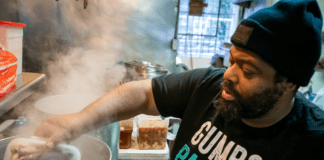
by Amani Sawari
This time last year thousands of prisoners were buckling down in preparation for a national demonstration that would not only put their jobs at stake, but that also put many lives on the line – all in an attempt to raise awareness about the oppressive conditions of United States prisons. Incarcerated citizens united nationwide across dozens of regions under the common banner of 10 demands that ranged from universal concerns, such as the fight to improve prison conditions and to end prison slavery, as well regionally specific requests that included the rescinding of oppressive laws such as the Prisoner Litigation Reform Act (PLRA) truth-in-sentencing (TIN) laws and long mandatory minimums.
Prisoners demanded to see a change in the corrections system to one that focused on an investment into the humanity of incarcerated citizens through expanding Pell Grant funding and increasing access to rehabilitative programming as well the restoration of their voting rights. To sum it up, prisoners wanted to see an investment into their future rather than the demolition of futures through the heavy punitive punishments of one’s past.
Why it happened
We are all aware of the fact that that our criminal justice system is more focused on punishment and does a much better job at further damaging people who are already suffering from various forms of trauma. Prisoners don’t just want prison to be more comfortable; they want prisons to be more effective at making them better people.
Prisoners want prison to be a safer environment and they want it to be a place where a person can transform from who they were into who they were meant to be. Unfortunately, with the way operations are structured right now. the United States criminal justice system is not able to do that at all. Even worse than that fact, prisons have become death traps, where inmates live with the daily stress of ongoing violence.
On April 15, 2018, prisoners were in the middle of a lockdown. Lockdown conditions can be described as prison within a prison where restrictions are increased to limit movement and withhold privileges. During lockdown, prisoners are kept in their cells for at least 23 hours a day. They are not allowed any visits, phone calls, recreation time, mail, classes or other programs. They are not even allowed to leave their cells to eat or shower.
In general population these conditions force grown adults to cohabitate in small spaces for extended periods of time, often months and even years. At Lee County, these conditions worsened as a result of gladiator switches, where officials allowed inmates from rival groups to be held in the same spaces. With tensions rising due to the misery of the conditions, there’s no wonder why some inmates go insane.
The conditions reached their breaking point at 7:15 p.m., when fights began. As one group fought, more caught on in defense. With nothing else to do and staff refusing to intervene for over seven hours, several men lost their lives: Corey Scott, Eddie Casey Gaskins, Raymond Angelo Scott, Damonte Rivera, Michael Milledge, Cornelius McClary and Joshua Jenkins.
The event is known as the Lee County Massacre due to the complete disregard of prison officials who pushed inmates to their limit and then watched them beat each other to death for the entire day. The tragedy inspired activists on the inside to take action. They knew that Lee County was not the only prison where similarly devastating losses occurred. There are dozens, if not hundreds of prisons across the county on lockdown at any given moment.
Realizing this, Jailhouse Lawyers Speak, a national group of incarcerated legal workers, connected with outside activists to support them in planning a national demonstration during the historic month of Black August.
What happened in the process
In the process of organizing the National Prison Strike, where thousands of people participated in 35+ prisons across 22 regions of the country, prisoners demonstrated their ability to organize across state and international borders. This substantially impacted the national narrative surrounding prisoner resistance, dramatically transforming many from being on the fence to being in support of prisoners seeking prevailing wages, rehabilitation and access to education.
Along with a change in the national consciousness, major media like Democracy Now and BBC had also caught on to the strike and now regularly follow prisoner resistance movements. Most significantly, prisoner resistance, rather than being seen as an illegitimate act of chaos, is now perceived as a legitimate pathway towards policy reform. Criminal Justice Reform and the protection of prisoners’ basic human rights has quickly grown towards a national priority.
With careful attention paid to the 10 demands, people who had formerly been ignorant to the complex issues that exist within U.S. prisons, jails and detention centers now had a succinct list of points to resolve. Though organizers and participants did not expect any immediate response from politicians or prison officials, there were some significant changes that occurred during the strike.
For example, phone call rates lowered in multiple states, including Texas and Michigan. Along with this, outside supporters organized phone zaps in response to instances of retaliation. Phone zaps are the act of outside supporters calling in mass to the facility to inquire about the status of an individual or group of inmates suffering from some form of administrative oppression. Organizers on both sides of the wall were able to build their networks, strengthen their communication methods and solidify strategies to dismantle the prison industrial complex.
What’s happening now
One year later, Jailhouse Lawyers Speak are pleased to see that the issues that were raised with the national prison strike demands have risen to the level of national attention in the 2020 presidential election. Presidential candidate Sen. Bernie Sanders has released the most progressive, comprehensive criminal justice plan that we’ve seen to date.
Surprisingly, every one of the national demands is addressed in Bernie Sanders’ criminal justice reform plan. The proposal addresses Demand No. 1, “Immediate improvements to the conditions of prisons and prison policies that recognize the humanity of imprisoned men and women” by establishing a Prisoners’ Bill of Rights. Within the Prisoners’ Bill of Rights, we see Demand No. 10 fulfilled, restoring prisoners’ right to vote.
We also see Demand No. 2, which calls for “an immediate end to prison slavery” satisfied by mandating that prisoners be paid a living wage for their labor. With a Bill of Rights, a foundation is created to address human rights violations that are invalidated by the Prison Litigation Reform Act, illustrated in Demand No. 3, “The Prison Litigation Reform Act must be rescinded, allowing imprisoned humans a proper channel to address grievances and violations of their rights.”
The proposal doesn’t end there; it expands across all of the demands, including Nos. 4, 5 and 6 that call for an end to over-charging and over-sentencing by abolishing three-strike laws, gang enhancement laws, truth-in-sentencing laws and mandatory minimums. As a result of the execution of this proposal we will see a lot of individuals who suffer from gross over-sentencing be relieved from the weight of such discrimination and judicial misconduct.
Along with a commitment to improve the conditions of those incarcerated citizens who put their lives on the line to participate in the National Prison Strike to bring these issues to the forefront, Bernie addresses demands No. 7, 8 and 9 with a commitment to invest in rehabilitative programming and increase options for alternatives to prison while using incentives to cut the overall prison population in half.
With the introduction of this proposal, we can see that Bernie Sanders understands that our criminal justice system is more about the justice that one can afford rather than what they deserve and that it thrives on the exploitation of incarcerated people by economically crippling them and their families while erasing them politically through the denial of their right to vote.
He not only has an understanding of these problems, but he insists on correcting these complex issues rather than shying away from them. This plan is more of a restructuring plan than a reform plan with a focus on removing the profiteering aspect from the prison industrial complex in a number of ways that include ending private prisons and cash bail, making phone and video calls free, as well as eliminating re-entry and monitoring program fees.
It’s incredible to see how in just one year there has been a transformation in the way that people think about the role of incarcerated citizens in the whole of society. We’ve been able to see the weight of prisoners’ influence in politics through their ongoing resistance. This proves that with persistence and consistency, as a people united in vision, we can accomplish the seemingly impossible.
I’m thrilled to see that this prisoners’ human rights movement has reached the level of presidential discussion. It wasn’t long ago that people thought that these demands were too radical and would never be accomplished. Who knew that “never” was only one year long?
Amani Sawari is the spokesperson for Jailhouse Lawyers Speak, coordinated the 2018 National Prison Strike and now, as a Roddenberry Fellow, is coordinating the Right2Vote Campaign for prisoners’ right to vote. She can be reached at amanisawari@gmail.com or @Sawarimi. Visit her website, http://sawarimi.org.

 Store
Store












